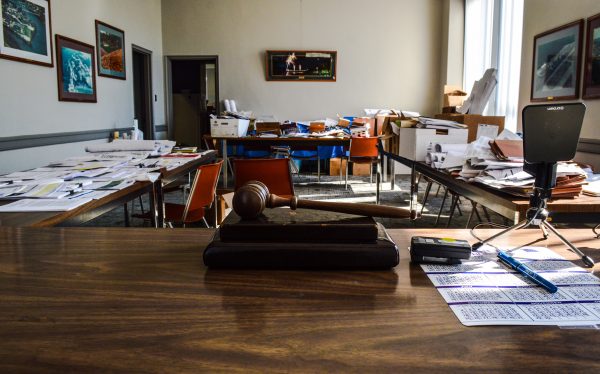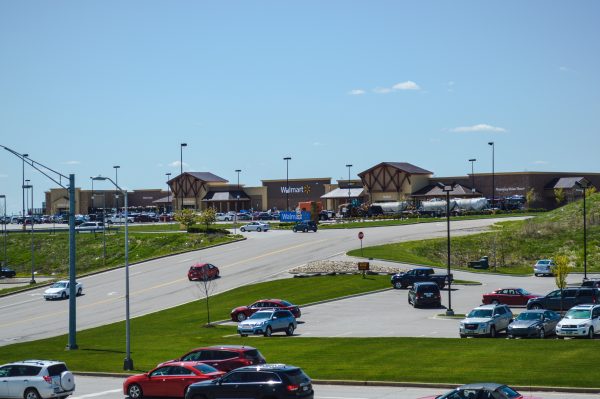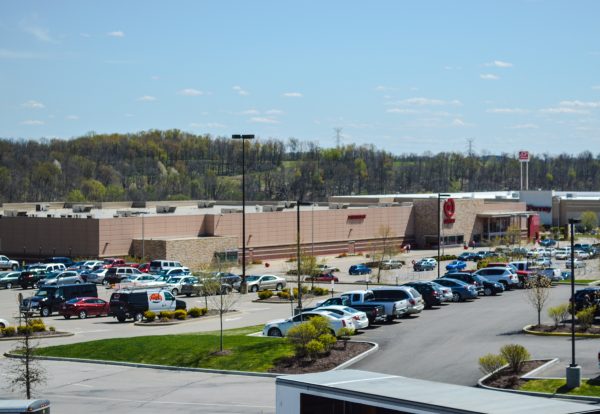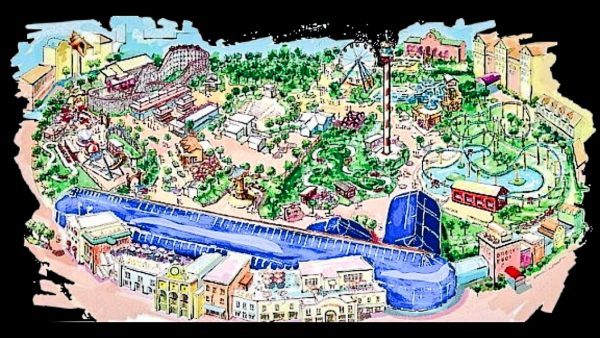It was supposed to be a $200 million, three-section, 100-acre theme park and not just a waterpark.
Outdoor and indoor roller coasters, a “giant-sized” children’s area, a three-story carousel with its own elevator, a 900-room hotel with an indoor water slide feature, and an 8,000-seat amphitheater were a few of the most exciting revelations on July 26, 2006, when developer Steve Minard announced the project.
Minard was born and raised in Iowa, established a career as an amusement developer, and he was a dreamer who genuinely believed Ohio County was a plausible location for such an attraction. His dream was “Wild Escape,” a “small city,” as he explained it, and Minard said the facility would be the first of 22 similar developments around the county.

The developer estimated the park would employ as many as 1,500 workers during fair-weather months and approximately 400 during the winter season.
Minard was requesting “TIF financing” for infrastructure needs. TIF, or tax increment financing, allows a local government to capture the projected growth in tax revenues in a specific development area to help finance additional development in that same area. He was afforded office space on the second floor of the City-County Building in downtown Wheeling, and on many occasions he was featured on local radio stations, television stations, and in newspaper articles. In one interview he described his “kiddie-land” concept as follows:
“Junior Bigs is the son of a couple of giants, so his toys are, of course, much larger than the toys that we have played with. The good news is that Junior is not around very often because he goes to boarding school, and then he goes to summer camp, but when he is here, he leaves his toys lying around.
“That means we get to play with those toys like a giant swing set and footballs and whatever else he may leave lying around. Everything in that area will be larger than life, and people are going to be amazed.”
Minard’s contact information is no longer activated so efforts to reach him for comment proved unsuccessful, but two current Ohio County commissioners who were directly involved with the theme park process explained that if the economic crash in November 2008 had not happened the theme park could be located at The Highlands.

“The biggest issues with the theme park project were the timing and what happened to the economy,” explained Ohio County Commissioner Orphy Klempa. “At that time I was a member of the Ohio County Development Authority, and I can tell you that when the bottom fell out, and everything came to halt, no one was building anything after that.
“The banks got very serious about lending money, and the regulations that were implemented afterward have made it more difficult to get the loans that would be needed for a project of that size. Before that, I can tell you that a theme park at The Highlands was definitely on our plate,” he continued. “It was a part of the original big picture for The Highlands, and everyone wanted it to happen. We believed in it.”
Minard surprised everyone with his confirmation of the project, Ohio County Commissioner Randy Wharton recalled, and the public reaction was intense because of how “out of the box” the concept was at the time. The developer described the project as “moving a mountain, literally, to build a small city.”
“The theme park project was a huge project that was going to cost, at that time, at least $200 million, but then the economy crashed, and development shut down all over the country,” recalled Ohio County Commissioner Randy Wharton. “We thought it could have been great at the time, but there were a lot of steps to take before that announcement should have been made. The good news is that Ohio County did not spend any money to further that project.
“The ball was completely in Steve Minard’s court. Before the development authority would have spent the first dollar, he had a lot to do and a lot to pay for,” he said. “It was going to be an interesting process, but there were a lot more permits that would have been involved and a lot of environmental agencies, too.”

During that late-July afternoon, Ohio County Administrator Greg Stewart announced the agreements with Olive Garden, the AT&T Customer Service Center, and they allowed Minard to address the media too. The amusement park, though, swiped all the headlines.
“Sen. Jay Rockefeller was here because he was very instrumental with bringing the AT&T Center to The Highlands,” said Wharton. “And Steve Minard and his theme park proposal were in the mix. He wanted to make a presentation about what he wanted to do, and we allowed it. That was a mistake.
“In hindsight, if we were in the same situation today, Steve Minard would not make that presentation,” he continued. “It was a mistake and a lesson learned because it wasn’t a done deal. We meet with people most days and these people have some grand plans for The Highlands, but you’ll never hear about it unless it’s a done deal.”
Approximately 650 acres of the 1,000 acres available at The Highlands have been developed, and more flat surface could be created via earthwork, so the space remains if Minard and his “Wild Escape” were to resurface. Klempa and Wharton, however, insisted the theme park idea is a dream of the past.
“It’s no longer on our radar, and I can tell you that I have lost confidence in the gentleman who had proposed it to us in the very beginning,” Klempa said. “We have had a lot of new businesses open since this development went away, and we will have many more in the future, but one of them will not be this theme park concept.

“But I can tell you that we are still looking at all of the available options so we can add the entertainment element at the development that would attract people from a 150-mile radius as well as our local residents,” the commissioner said. “But I can tell you one thing: If and when we have a real good possibility, it will remain under wraps until we dot the i’s and cross the t’s.
“What happened with the theme park is a perfect example why we refuse to make any of those kinds of announcements. That gentleman, we know now, jumped the gun before everything was set in stone, and that’s why these days we just let everyone know that there’s always something in the works for that area.”
Wharton not only serves as an Ohio County commissioner, but he also is the president of the Ohio County Development Authority, the business-side of the county’s hilltop development.
“And I tell you that I have not spoken to Minard for at least five years, and I have no idea what he’s doing these days,” he said. “But our focus has shifted away from a project like that to more diversification. There’s a lot of interest in The Highlands, so we are hoping to continue adding retail and restaurants as well as soft industry.
“We’re not going to stop developing The Highlands until we have to,” he continued. “We just added several businesses in the area of the Fusion Restaurant, and there will be some announcements soon. But that’s all I can tell you.”

Whether or not a theme park would have proven successful in Ohio County is a question not to be answered anytime soon, and Klempa admitted the past six years have altered his outlook.
“I know a lot of the people in this area were excited about the theme park when Minard announced it, but if we can’t even fill Wesbanco Arena for a Nailers game or pack the Capitol Theatre for many of the events they have there, what makes anyone think that the economy in this area would have been able to support that kind of park?
“I know it may have attracted people from a pretty good radius, but a lot of that concept also depended on the support of the local population, but people have to have that kind of disposable income,” he said. “Until we can get the kind of jobs in this area that supply that kind of income, I don’t see such a thing working in this county.”
As soon as the theme park proposal was adopted by the Ohio County Development Authority, the need for a second way for motorists to travel in and out of The Highlands was addressed. The project, with an estimated cost of $30 million in 2007, has yet to come to fruition, but Wharton confirmed hope remains alive that it will in the future.
“I think at some point the second interchange will be constructed, but the funding is always an issue. We have a deal with the state and the legislature, though, and we intend to live up to our half of that deal,” Wharton said. “A deal is a deal, as far as we are concerned, as we believe there will be a need for a second way in and out in the future.
“I hope it happens in the future, and we are more than willing to work with the state to make it happen,” he continued. “And I hope it happens within 10 years, maybe sooner than that because it would also open up land owned by the RED (Regional Economic Development Partnership) for future development.”

Wharton, Klempa, and Ohio County Commissioner Tim McCormick were all surprised this past week with the sudden closure of the Cracker Barrel Restaurant on Fort Henry Road, but Wharton and Klempa insisted the company’s decision does not reflect a decrease in the development area.
“(Ohio County Administrator) Greg Stewart did not get the notification letter from the company until the day after the company decided to close it down the way they did,” Wharton said. “I don’t think anyone would disagree that it was a pretty poor way to do business, but now they are gone, and we will survive just fine.”
“The property is owned by the Ohio County Development Authority,” Klempa reported, “and the company will continue paying for their lease for the next six months. But they aren’t going to pick up the building, so we’ll have that property too for the next business to use.
“I was surprised by the sudden closure because I have always made a point to drive past it when I’m in that area,’ and it always seemed to me as if they were doing well,” he continued. “I do believe what they did with the sudden closure was a horrible thing to do to their employees, but I guess that’s how corporate America goes about their business sometimes.”
(Photos by Steve Novotney; images provided by Steve Minard)





